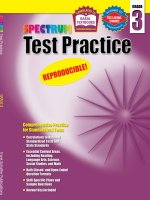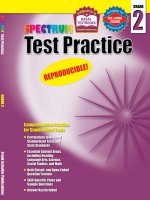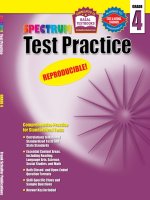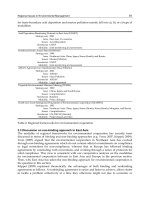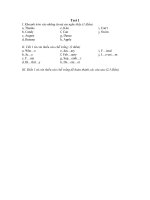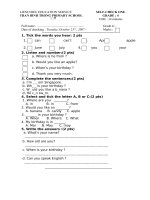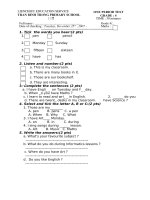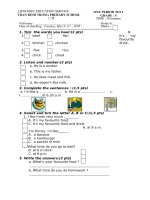Spectrum Test Practice, Grade 4 pot
Bạn đang xem bản rút gọn của tài liệu. Xem và tải ngay bản đầy đủ của tài liệu tại đây (2.6 MB, 162 trang )
Test Practice
GRADE 4
From the Premier Educational Publisher
Spectrum Test Practice helps young learners gain confidence by working with actual test
questions and answer sheets.
This workbook offers students
Skill lessons with test-taking clues and sample questions to help students become familiar with
test formats and content.
Preliminary sample tests with guided instructions, followed by comprehensive practice tests.
Confidence-building practice in reading, language arts, writing, basic skills, science,
social studies, and math.
An answer sheet that simulates the actual testing experience.
This workbook offers teachers
Correlations to state standards and standardized tests including TerraNova CAT ™ and CTBS®.
A comprehensive practice test for each subtopic.
Skill lessons to use as independent work in centers, for homework, or as seatwork.
Look for these additional titles to help your students build essential skills in the
following key subject areas:
Basic Concepts and Skills (Preschool)
Learning Letters (Preschool)
Math Readiness (Preschool)
Dolch Sight Words (Grades K–1)
Geography (Grades 3–6)
Language Arts (Grades 2–6)
Math (Grades K–8)
Phonics (Grades K–6)
Reading (Grades K–6)
Spelling (Grades 1–6)
Writing (Grades 1–8)
Enrichment Math and Reading (Grades 3–6)
Test Prep (Grades 1–8)
•
•
•
•
•
•
•
•
•
•
•
•
SPECTRUM SERIES
•
•
ISBN 1-57768-974-7
Visit our Web site at
www.FrankSchaffer.com
Frank Schaffer Publications
Grade 4
Published by Spectrum
an imprint of
Frank Schaffer Publications
®
Spectrum is an imprint of Frank Schaffer Publications.
Printed in the United States of America. All rights reserved. Limited Reproduction Permission: Permission
to duplicate these materials is limited to the person for whom they are purchased. Reproduction for an
entire school or school district is unlawful and strictly prohibited. Frank Schaffer Publications is an imprint
of School Specialty Publishing. Copyright © 2003 School Specialty Publishing.
Send all inquiries to:
Frank Schaffer Publications
3195 Wilson Drive NW
Grand Rapids, Michigan 49534
Spectrum Test Practice—grade 4
ISBN: 1-57768-974-7
3 4 5 6 7 8 9 10 PHXBK 09 08 07 06 05 04
Editors: Sara Bierling and Kathryn Wheeler
Frank Schaffer Publications
®
Published by Spectrum. Copyright protected.
1-57768-974-7 Spectrum Test Practice 4
3
SPECTRUM TEST PRACTICE
Introduction 4
Letter to Parent/Guardian 7
Correlation to Standards 8
Reading
Vocabulary
Synonyms 11
Vocabulary Skills 12
Antonyms 13
Multi-Meaning Words 14
Words in Context 15
Word Study 16
Sample Test: Vocabulary 17
Comprehension
Main Idea 21
Recalling Details/Sequencing 22
Inferencing/Drawing Conclusions 23
Fact & Opinion/Cause & Effect 24
Parts of a Story 25
Fiction 26
Nonfiction 32
Sample Test: Reading Comprehension 38
Reading Practice Test: Answer Sheet 44
Reading Practice Test 45
Language
Mechanics
Punctuation 58
Capitalization & Punctuation 60
Sample Test: Language Mechanics 63
Expression
Usage 67
Sentences 70
Paragraphs 73
Sample Test: Language Expression 77
Spelling
Spelling 81
Sample Test: Spelling 83
Study Skills
Study Skills 85
Sample Test: Study Skills 87
Language Practice Test: Answer Sheet 90
Language Practice Test 91
Math
Concepts
Numeration 102
Number Concepts 104
Properties 106
Fractions & Decimals 108
Sample Test: Concepts 110
Computation
Addition & Subtraction of Whole Numbers 112
Addition & Subtraction of Fractions 113
Addition & Subtraction of Decimals 115
Multiplication of Whole Numbers 116
Division of Whole Numbers 117
Sample Test: Computation 118
Applications
Geometry 120
Measurement 123
Problem Solving 127
Sample Test: Applications 131
Math Practice Test: Answer Sheet 135
Math Practice Test 136
Science
Concepts 145
Applications 146
Science Practice Test: Answer Sheet 147
Science Practice Test 148
Social Studies
Concepts 150
Applications 151
Social Studies Practice Test: Answer Sheet152
Social Studies Practice Test 153
Answer Key 155
Table of Contents
Grade 4
INTRODUCTION
With increased accountability in ensuring
academic success for all learners, testing now takes a
significant amount of time for students in all settings.
Standardized tests are designed to measure what
students know. These tests are nationally normed.
State tests are usually tied to specific academic
standards identified for mastery.
For many students, testing can be a mystery.
They fear not doing well and not knowing what to
expect on the test. This Spectrum Test Practice book
was developed to introduce students to both the
format and the content they will encounter on tests. It
was developed on the assumption that students have
received prior instruction on the skills included. This
book is designed to cover the content on a
representative sample of state standards. The
sampling of standards is found on pages 8–10 with a
correlation to the skills covered in this book and a
correlation to sample standardized tests. Spaces are
provided to record the correlation to the tests being
administered by the user of this book. Spaces are
also provided to add standards that are specific to the
user.
Features of Spectrum Test Practice
• Skill lessons, sample tests for subtopics, and
comprehensive content area tests
• Clues for being successful with specific skills
• Correlation of skills to state standards and
standardized tests
• Format and structure similar to other formal
tests
• Written response required in the Science and
Social Studies sections
• Reproducible for use by a teacher for a
classroom
Overview
This book is developed within content areas
(Reading, Language, Math, Science, and Social
Studies). A comprehensive practice test follows at the
end of the content area, with an answer sheet for
students to record responses. Within each content
area, specific subtopics have been identified. Sample
tests are provided for each subtopic. Within each
subtopic, specific skill lessons are presented. These
specific skill lessons include an example and a clue
for being successful with the skill.
Comprehensive Practice Test
A comprehensive practice test is provided for
each content area. The subtopics for each area are
identified below:
• Reading
• Vocabulary (synonyms, antonyms, word
meanings, multi-meaning words, root
words, affixes, and words in context)
• Reading Comprehension (main idea,
recalling details, sequencing, inferencing,
drawing conclusions, fact and opinion,
cause and effect, and author’s purpose in
fiction and nonfiction articles)
• Language
• Language Mechanics (capitalization and
punctuation)
• Language Expression (usage, sentences,
and paragraphs)
• Spelling (both correct and incorrect
spelling)
• Study Skills (dictionary skills, reference
materials, reading tables and graphs,
book parts)
Published by Spectrum. Copyright protected.
1-57768-974-7 Spectrum Test Practice 4
4
INTRODUCTION
• Math
• Concepts (numeration, number concepts,
fractions and decimals, algebra,
properties)
• Computation (addition and subtraction of
whole numbers, fractions, and decimals;
multiplication and division of whole
numbers)
• Applications (geometry, measurement,
and problem solving)
• Science*
• Electricity/Magnetism
• Plant and Animal Structures
• Water/Weather Cycles
• Human Body
• Astronomy
• Social Studies*
• United States Regions
• State History
• World Regions/Climates
• Map Skills
• Economics
*Since states and often districts determine units
of study within Science and Social Studies, the
content in this book may not be aligned with the
content offered in all courses of study. The content
within each area is grade level appropriate. It is
based on a sampling of state standards. The tests in
Science and Social Studies include both multiple
choice and written answer.
Comprehensive Practice Test Includes
• Content Area (i.e. Language)
• Subtopics (i.e. Language Mechanics)
• Directions, examples, and test questions
• Separate answer sheet with “bubbles” to be
filled in for answers
Sample Tests
Sample tests are included for all subtopics. These
sample tests are designed to apply the knowledge
and experience from the skill lessons in a more
formal format. No clues are included. These sample
tests are shorter than the comprehensive tests and
longer than the skill lessons. The skills on the test
items are presented in the same order as introduced
in the book.
Sample Tests Include
• Subtopic (i.e. Language Mechanics)
• Directions, examples, and test questions
Skill Lessons
Skill lessons include sample questions and clues
for mastering the skill. The questions are formatted as
they generally appear in tests, whether the tests are
standardized and nationally normed or state specific.
Skill Lessons Include
• Subtopic (i.e. Language Mechanics)
• Skill (i.e. Punctuation)
• Directions and examples
• Clues for completing the activity
• Practice questions
Use
This book can be used in a variety of ways,
depending on the needs of the students. Some
examples follow:
• Review the skills correlation on pages 8–10.
Record the skills tested in your state and/or
district on the blanks provided.
• Administer the comprehensive practice test for
each content area. Have students use the
sample answer sheet in order to simulate the
actual testing experience. The tests for Reading,
Language, and Math are multiple choice.
Evaluate the results.
Published by Spectrum. Copyright protected.
1-57768-974-7 Spectrum Test Practice 4
5
INTRODUCTION
• Administer the sample test for the subtopics
within the content area. Evaluate the results.
• Administer the specific skill lessons for those
students needing additional practice with
content. Evaluate the results.
• Use the skill lessons as independent work in
centers, for homework, or as seatwork.
• Prepare an overhead transparency of skill
lessons to be presented to a group of students.
Use the transparency to model the skill and
provide guided practice.
• Send home the Letter to Parent/Guardian found
on page 7.
Clues for Getting Started
Determine the structure for implementing
Spectrum Test Practice. These questions may help
guide you:
• Do you want to assess the overall
performance of your class in each
academic area? If so, reproduce the
practice test and sample answer sheet for
each area. Use the results to determine
subtopics that need additional instruction
and/or practice.
• Do you already have information about
the overall achievement of your students
within each academic area? Do you need
more information about their achievement
within subtopics, such as Vocabulary
within Reading? If so, reproduce the
sample tests for the subtopics.
• Do your students need additional practice
with some of the specific skills that they
will encounter on the standardized test?
Do you need to know which students
have mastered which skills? These skill
lessons provide opportunities for
instruction and practice.
• Go over the purpose of tests with your students.
Describe the tests and the testing situation,
explaining that the tests are often timed, that
answers are recorded on a separate answer
sheet, and that the questions cover material
they have studied.
• Do some of the skill lessons together to help
students develop strategies for selecting
answers and for different types of questions.
Use the “clues” for learning strategies for test
taking.
• Make certain that students know how to mark a
separate answer sheet. Use the practice test
and answer sheet so that they are familiar with
the process.
• Review the directions for each test. Identify key
words that students must use to answer the
questions. Do the sample test questions with
the class.
• Remind students to answer each question, to
budget their time so they can complete all the
questions, and to apply strategies for
determining answers.
Reduce the mystery of taking tests for your
students. By using Spectrum Test Practice, you have
the materials that show them what the tests will look
like, what kinds of questions are on the tests, and
ways to help them be more successful taking tests.
Note: The comprehension questions in reading in
all selections are in the same order: main idea,
recalling details/sequencing, inferencing/drawing
conclusions, fact and opinion/cause and effect. This
information can be used to diagnose areas for
needed instruction.
Note: If you wish to time your students on a
practice test, we suggest allowing 1.25 minutes per
question for this grade level.
Published by Spectrum. Copyright protected.
1-57768-974-7 Spectrum Test Practice 4
6
Dear Parent/Guardian:
We will be giving tests to measure your child’s learning. These tests include
questions that relate to the information your child is learning in school. The tests may be
standardized and used throughout the nation, or they may be specific to our state.
Regardless of the test, the results are used to measure student achievement.
Many students do not test well even though they know the material. They may not
test well because of test anxiety or the mystery of taking tests. What will the test look
like? What will some of the questions be? What happens if I do not do well?
To help your child do his/her best on the tests, we will be using some practice tests.
These tests help your child learn what the tests will look like, what some of the questions
might be, and ways to learn to take tests. These practice tests will be included as part of
your child’s homework.
You can help your child with this important part of learning. Below are some
suggestions:
• Ask your child if he/she has homework.
• Provide a quiet place to work.
• Go over the work with your child.
• Use a timer to help your child learn to manage his/her time when taking tests.
• Tell your child he/she is doing a good job.
• Remind him/her to use the clues that are included in the lessons.
If your child is having difficulty with the tests, these ideas may be helpful:
• Review the examples.
• Skip the difficult questions and come back to them later.
• Guess at those that you do not know.
• Answer all the questions.
By showing you are interested in how your child is doing, he/she will do even better
in school. Enjoy this time with your child. Good luck with the practice tests.
Sincerely,
Published by Spectrum. Copyright protected.
1-57768-974-7 Spectrum Test Practice 4
7
Published by Spectrum. Copyright protected.
1-57768-974-7 Spectrum Test Practice 4
8
CORRELATION TO STANDARDS
Reading
Vocabulary
Using Synonyms x x x
Using Antonyms x x
Using Homographs x
Using Idioms
Using Multi-Meaning Words x x
Using Context Clues x x
Using Common Roots and Word Parts x
Other
Comprehension
Identifying Main Idea x x x
Identifying Supporting Details x x x
Identifying Sequence of Events x x x
Drawing Conclusions x x x
Making Predictions x x x
Comparing and Contrasting x x x
Identifying Cause and Effect x x
Identifying Character Traits/Feelings x x x
Identifying Story Parts x
Distinguishing Between Fact and Opinion x
Using Graphic Organizers x x
Understanding Figurative Language x x
Summarizing x x x
Identifying Author’s Purpose x x
Reading Various Genres x x
Other
Language
Mechanics
Expression
Using Correct Capitalization and Punctuation x x x
Determining Correct Usage x x x
Recognizing Simple Subjects and Predicates x x
Combining Sentences x x x
Using Simple and Compound Sentences x x
Identifying Topic Sentences for Paragraphs x x x
Identifying Supporting Sentences for Paragraphs x x x
Other
Spelling
Identifying Correct Spelling x x
Identifying Incorrect Spelling x x
Other
Grade 4
Other
Spectrum Test Practice Gr. 4
*CAT Level for Gr. 4
**CTBS Level for Gr. 4
Other
Other
Sample Standards
* Terra Nova CAT™ ©2001 CTB/McGraw-Hill
** Terra Nova CTBS® ©1997 CTB/McGraw-Hill
Published by Spectrum. Copyright protected.
1-57768-974-7 Spectrum Test Practice 4
9
CORRELATION TO STANDARDS
Study Skills
Using Reference Materials x x
Interpreting Graphs and Tables x
Using Books Parts x
Using Graphic Organizers x
Reading Maps x
Other
Math
Concepts
Numeration
Using Number Lines x x
Using Numbers Up To 1,000,000 x x
Rounding Whole Numbers Up To 10,000
Ordering and Comparing Whole Numbers x x
Renaming Whole Numbers As Fractions
Using Mixed Numbers and Improper Fractions x
Using Place Value x x
Other
Algebra
Recognizing Patterns with Pictures x x
Extending Number Patterns x x x
Using Number Sentences x x x
Using Symbols To Represent Numbers x x x
Other
Fractions and Decimals
Writing 10ths and 100ths In Fraction and Decimal Notation x
Rounding Decimals x
Ordering Fractions and Decimals x
Adding and Subtracting Fractions and Decimals x
Using Pictures or Objects
Recognizing Fractions and Decimals from Pictures x x
Other
Computation
Whole Numbers
Using Standard Algorithms for Operations x x x
Using Mental Arithmetic for Adding and Subtracting x
Rounded Numbers
Estimating x x x
Other
Fractions and Decimals
Adding and Subtracting Fractions and Decimals x x
Using Pictures or Objects
Using Standard Algorithms for Adding and Subtracting Decimals x x x
Other
Grade 4
Other
Spectrum Test Practice Gr. 4
*CAT Level for Gr. 4
**CTBS Level for Gr. 4
Other
Other
Sample Standards
* Terra Nova CAT™ ©2001 CTB/McGraw-Hill
** Terra Nova CTBS® ©1997 CTB/McGraw-Hill
* Terra Nova CAT™ ©2001 CTB/McGraw-Hill
** Terra Nova CTBS® ©1997 CTB/McGraw-Hill
Published by Spectrum. Copyright protected.
1-57768-974-7 Spectrum Test Practice 4
10
CORRELATION TO STANDARDS
Probability
Interpreting Data x x
Other
Applications
Geometry
Identifying Lines, Angles, and Shapes x x x
Identifying Lines of Symmetry x x
Identifying Congruent Figures x
Other
Measurement
Estimating
Measuring to Nearest Eighth-inch and Millimeter x x
Renaming Feet to Inches and Meters to Centimeters x
Finding Perimeter and Area of Squares and Rectangles x x x
Using Volume, Mass, and Capacity x x
Adding Time Intervals x
Making Change x
Other
Problem Solving
Selecting Appropriate Operations x x x
Using a Variety of Methods to Solve Problems, x x x
Including Graphs, Tables, and Charts
Identifying Relevant and Irrelevant Information x x
Estimating Results x x
Selecting Reasonable Solutions x
Calculating Multi-step Problems x x x
Other
Science
Understanding the Concept of Recycling x x
Comparing Fresh and Ocean Waters x
Understanding Light and Heat x x x
Understanding Magnetism x x
Understanding Plant and Animal Structures x x x
Understanding Earth/Sun Relationships x x x
Understanding the Water Cycle x
Other
Social Studies
Understanding the History of the State x
Identifying the Branches of Government x x
Understanding the Geography of the State Region x
Applying the Basic Vocabulary of Economics x x
Interpreting Maps/Graphic Organizers x x x
Interpreting Time Lines x x
Other
Grade 4
Other
Spectrum Test Practice Gr. 4
*CAT Level for Gr. 4
**CTBS Level for Gr. 4
Other
Other
Sample Standards
Examples
READING: VOCABULARY
Published by Spectrum. Copyright protected.
1-57768-974-7 Spectrum Test Practice 4
11
Name _________________________________________________ Date_____________________
Lesson 1: Synonyms
Directions:
Read each item. Choose the word that means the same or about the same as the
underlined word.
A. fast vehicle
A
runner
B
animal
C
car
D
computer
B. To be healthy is to be —
F
slow
G
well
H
active
J
ill
1. attend a conference
A
party
B
game
C
meeting
D
race
2. beautiful painting
F
pretty
G
interesting
H
colorful
J
light
3. repair the car
A
clean
B
drive
C
fix
D
sell
4. thin slice
F
short
G
skinny
H
long
J
wide
5. To r u s h t h r ough your homework is to —
A
relax
B
slow
C
finish
D
hurry
6. Raw vegetables are —
F
uncooked
G
green
H
smelly
J
young
7. A dim light bulb is —
A
dull
B
bright
C
unintelligent
D
new
8. To walk quickly is to walk —
F
confidently
G
carefully
H
rapidly
J
happily
Practice
Make sure you look at the underlined word.
Fill in the circle next to the synonym.
Examples
READING: VOCABULARY
Published by Spectrum. Copyright protected.
1-57768-974-7 Spectrum Test Practice 4
12
Name _________________________________________________ Date_____________________
Lesson 2: Vocabulary Skills
Directions:
Read each item. Choose the word that means the same or about the same as the
underlined word.
A. detect a clue
A
to find
B
to hide
C
to enjoy
D
to make up
B. She had to select the book for the
next meeting. To select is to —
F
find
G
review
H
read
J
choose
1. venomous snake
A
vicious
B
poisonous
C
sharp
D
huge
2. encourage friends
F
fascinate
G
worry
H
cheer up
J
disappoint
3. mature person
A
grown-up
B
dying
C
new
D
green
4. The teacher was irritated.
Irritated means —
F
excited
G
helpful
H
annoyed
J
boring
5. His pants were baggy.
Baggy means —
A
loose
B
brown
C
too small
D
made of cotton
6. He was the first conductor of the train.
A conductor is a —
F
driver
G
janitor
H
owner
J
rider
7. Sharon was elated when she won.
Elated means —
A
grim
B
joyful
C
outside
D
unpleasant
Practice
Make sure you look at the underlined word.
Eliminate answer choices you know are wrong.
Examples
READING: VOCABULARY
Published by Spectrum. Copyright protected.
1-57768-974-7 Spectrum Test Practice 4
13
Name _________________________________________________ Date_____________________
Lesson 3: Antonyms
Directions:
Read each item. Choose the word that means the opposite of the underlined
word.
A. The tortoise took a leisurely walk.
A
lovely
B
swift
C
leathery
D
delicious
B. recall information
F
forget
G
remember
H
write
J
find
1. Leslie was disappointed when it
rained.
A
saddened
B
pleased
C
relieved
D
entertained
2. The car was fast.
F
shallow
G
sluggish
H
speedy
J
rabbit
3. The dog’s fur felt silky.
A
soft
B
smooth
C
rough
D
dirty
4. Banana slugs are moist to the touch.
F
dry
G
slimy
H
rough
J
rubbery
5. rough board
A
large
B
heavy
C
smooth
D
long
6. docile animal
F
vicious
G
gentle
H
shy
J
active
7. active child
A
immobile
B
exhausted
C
bored
D
thrilled
8. left promptly
F
late
G
recently
H
quietly
J
slowly
Practice
If you are not sure which answer is correct, take your best guess.
Eliminate answer choices you know are incorrect.
READING: VOCABULARY
Published by Spectrum. Copyright protected. 1-57768-974-7 Spectrum Test Practice 4
14
Name _________________________________________________ Date_____________________
Lesson 4: Multi-Meaning Words
Example
For items A and 1–2, choose the answer in
which the underlined word is used in the
same way as the sentence in the box.
For items 3–5, read the two sentences with
blanks. Choose the word that fits best in
both sentences.
A. Please file these papers.
A
The counselor pulled out her file
on the Jones family.
B
Sally used a file to smooth her
fingernails.
C
I put the file cards in order.
D
Jane asked her secretary to file
the reports on water safety.
1. I used a lemon to make lemonade.
A
The color of the baby’s room is
lemon.
B
That car was a lemon.
C
This cleaner has a lovely lemon
scent.
D
Rachel bought a lemon at the
store.
2. She could never reach the right note
on the piano.
F
Please make a note of this
change.
G
I wrote a note so you will not
forget.
H
The musical note he asked us to
play was C.
J
Note the large size of the
buildings.
3. Do you feel _________ ?
We get our water from a _________ .
A
well
B
good
C
pipe
D
sick
4. Mrs. Johnson said Carrie was a
_________ student.
The light from the headlights was
________ .
F
noisy
G
red
H
bright
J
hard working
5. The surface of the car was _________ .
Mr. Abed gave a _________ speech.
A
dirty
B
shiny
C
painted
D
dull
Practice
If a question is too difficult, skip it and come
back to it later if you have time.
READING: VOCABULARY
Published by Spectrum. Copyright protected.
1-57768-974-7 Spectrum Test Practice 4
15
Name _________________________________________________ Date_____________________
Lesson 5: Words in Context
Directions: Read the paragraph. Choose the word that fits best in each numbered blank.
Glass is an amazing substance. Made by
heating sand with a few other simple
chemicals, glass is both _________(1) and
beautiful. In the _________(2), you drink your
juice in a glass. At your school, you may
_________(3) the building through a glass
door. The lights inside the school are made of
glass, as is the _________(4) of the computer
you will use. If you go to gym class, the
basketball backboard might even be made of
glass. Your family may have pieces of glass as
decorations around the house, and if you go to
a _________(5), you might see _________(6)
glass from hundreds of years ago.
1.
A ugly
B useful
C cloudy
D thin
2.
F evening
G time
H morning
J mood
3.
A open
B see
C like
D enter
4.
F inside
G keyboard
H screen
J mouse
5.
A aquarium
B bus stop
C gas station
D museum
6.
F new
G antique
H full
J broken
Practice
Read the passage once. Then read each sentence with a blank
carefully. Use the meaning of the sentence to find the answer.
Examples
In-line skating might be the fastest-growing _________(A) in America. Typical _________(B)
follow roads, sidewalks, or bike paths. This sport is relatively new, but it is already enjoyed by
people young and old.
A.
A thing
B people
C town
D sport
B. F skaters
G vehicles
H hikers
J results
Examples
READING: VOCABULARY
Published by Spectrum. Copyright protected.
1-57768-974-7 Spectrum Test Practice 4
16
Name _________________________________________________ Date_____________________
Lesson 6: Word Study
Directions:
Read each item. Choose the answer you think is correct.
A. Which of these words probably comes
from the Latin word circuitus, meaning
a going around?
A
circus
B
circuit
C
cirrus
D
circa
B. Let’s _________ the ripe apples.
Which word means to gather the
ripe apples?
F
eat
G
collect
H
check
J
sell
1. Which of these words probably comes
from the Greek word logos, meaning
word or speech?
A
locate
B
logo
C
lodge
D
log
2. Which of these words probably comes
from the French word ravager,
meaning to uproot?
F
ravage
G
ravel
H
rave
J
ravine
3. The owner had to _________ the
puppy for chewing the shoes.
Which word means to speak harshly?
A
scold
B
pursue
C
alert
D
inspire
4. José _________ his report to include a
section on bugs.
Which word means he changed it by
adding something?
F
wrote
G
amended
H
erased
J
corrected
For items 5–6, choose the answer that best
defines the underlined part.
5. wonderful mouthful
A
to be doing
B
full of
C
outside
D
underneath
6. mistake mislead
F
correctly
G
before
H
to do after
J
wrongly
Practice
Mark the correct answer as soon as you find it.
Examples
Published by Spectrum. Copyright protected.
1-57768-974-7 Spectrum Test Practice 4
17
Name _________________________________________________ Date_____________________
For items A and 1–4, choose the word that
means the same or about the same as the
underlined word.
A. calm ocean
A
water
B
sea
C
lake
D
body
For items B and 5–8, read each item.
Choose the answer you think is correct.
B. Infect means—
F
to act
G
to cheer up
H
to spread disease
J
to discover
1. high fence
A
tall
B
happy
C
long
D
wide
2. paste the paper
F
fold
G
attach
H
patch
J
glue
3. fix the car
A
polish
B
repair
C
sell
D
buy
4. chilly day
F
long
G
frozen
H
cold
J
unpleasant
5. If something is moving swiftly, it is
moving —
A
slowly
B
smoothly
C
quickly
D
on the land
6. Shallow means —
F
not intelligent
G
deep
H
not deep
J
able to swim
7. To remain is to —
A
stay
B
leave early
C
go to the middle
D
do over again
8. That store was the nearest.
F
the most distant
G
biggest
H
best
J
the closest
READING: VOCABULARY
SAMPLE TEST
Published by Spectrum. Copyright protected.
1-57768-974-7 Spectrum Test Practice 4
18
Name _________________________________________________ Date_____________________
For items 9–13, choose the meaning for
each underlined word.
9. The wings of the butterflies were
fluttering in the breeze.
Fluttering means —
A
waving
B
colorful
C
lovely
D
flashing
10. Gazelles and impalas are prey to the
cheetah.
Prey means —
F
food
G
friends
H
similar
J
predators
11. David gave his sister a smirk.
Smirk means —
A
friendly smile
B
scar
C
smug expression
D
facemask
12. We were exhausted after running.
Exhausted means —
F
very tired
G
refreshed
H
excited
J
wide awake
13. I sprinted to the finish line.
Sprinted means —
A
skipped
B
crawled
C
ran very quickly
D
tripped
For items 14–19, choose the word that
means the opposite of the underlined wo rd .
14. valuable painting
F
strange
G
expensive
H
worthless
J
humorous
15. loose tie
A
tight
B
lost
C
plain
D
ill fitting
16. narrow ledge
F
thin
G
cement
H
skinny
J
wide
17. We a lw a y s use this road to go to sch o o l .
A
never
B
sometimes
C
usually
D
frequently
18. The wo r k e r s wanted to u n p a ck the truck .
F
carry
G
pack
H
remove
J
move
19. Tom was awake most of the night.
A
up
B
asleep
C
restless
D
watching TV
READING: VOCABULARY
SAMPLE TEST (cont.)
Published by Spectrum. Copyright protected. 1-57768-974-7 Spectrum Test Practice 4
19
Name _________________________________________________ Date_____________________
For items 20–23, read the two sentences
with blanks. Choose the word that fits best
in both sentences.
20. The sun _________ at 5:45.
A ________ grew beside the steps.
F
appeared
G
rose
H
flower
J
set
21. It’s not safe to _________ a boat.
This _________ is too heavy to move.
A
sink
B
stone
C
push
D
rock
22. What _________ will you be on
vacation?
I enjoy eating _________ .
F
days
G
fruit
H
weeks
J
dates
23. The captain took _________ of the
ship.
The cavalry made a great _________.
A
yell
B
charge
C
control
D
run
24. Follow the deer tracks.
In which sentence does the word
tracks mean the same thing as in the
sentence above?
F
The train moved swiftly on the
tracks.
G
Gerald tracks satellites for the
government.
H
The dog made tracks in the
snow.
J
Never stop your car on the train
tracks.
25. Hand me that green plant.
In which sentence does the word plant
mean the same thing as in the
sentence above?
A
The electric plant was a busy
place to work.
B
Plant those bushes here.
C
They used Joe as a plant to spy
on the kids.
D
I gave Mom a plant for Mother’s
Day.
For items 26–27, choose the answer that
best defines the underlined part.
26. motherless painless
F
with
G
like
H
more
J
without
27. magnify magnificent
A
magnetic
B
great
C
smaller
D
open
READING: VOCABULARY
SAMPLE TEST (cont.)
Published by Spectrum. Copyright protected.
1-57768-974-7 Spectrum Test Practice 4
20
Name _________________________________________________ Date_____________________
28. Which of these words probably comes
from the Latin word lampein, meaning
to shine?
F lampoon
G lament
H lamp
J lamprey
29. Which of these words probably comes
from the Middle English word wose,
meaning juice?
A ooze
B worst
C wowser
D wound
30. _________, Mom had forgotten the can
opener.
Which of these words means that it
was unlucky?
F Fortunately
G Mournfully
H Excitedly
J Unfortunately
31. Dave _________ around the room.
Which of these words means that he
walked in a bragging manner?
A tiptoed
B strutted
C ran
D skipped
Read the paragraph. Choose the word that
fits best in each numbered blank.
Leslie is becoming _________(32). People
know about her art and her athletics. She is
_________(33) in the music department for
her skills. I’m really _________(34) of what
she’s done.
32.
F famous
G released
H exhausted
J fragile
33.
A disliked
B prepared
C respected
D always
34.
F confused
G rejected
H lessened
J proud
READING: VOCABULARY
SAMPLE TEST (cont.)
Example
READING: READING COMPREHENSION
Published by Spectrum. Copyright protected.
1-57768-974-7 Spectrum Test Practice 4
21
Name _________________________________________________ Date_____________________
Lesson 7: Main Idea
Directions: Read the passage. Choose the best answer to the questions that follow.
Mario walked back and forth at the end of
the pool. He had been practicing his starts for
months, and today he would have a chance to
show off what he had learned. Just then Dave
walked into the building. Mario felt a lump in
his throat. Dave was the one person he would
have a hard time beating.
A. What is the main idea of this story?
A Mario has been practicing
jumping into the pool.
B Mario is nervous about beating
Dave in the swimming race.
C Dave is just as good at
swimming as Mario.
D Mario is a good swimmer.
Practice
Skim the passage again after you have read it. Then read the
questions. You don’t have to reread the story to answer each
question.
Thousands of immigrants arrived each day
at Ellis Island in New York. This was one of the
reception centers set up by the United States
government. The immigrants arrived with high
hopes. Many had a great deal to offer the United
States. However, not all those who came through
Ellis Island were allowed to stay in this country.
Immigrants had forms to fill out, questions
to answer, and medical exams to face. They
waited for many hours in the Great Hall to hear
their names called. Many had spent months in
poor conditions on ships to come to the United
States to make a better life. They had spent
their savings to make the trip. Even after this,
some were turned away.
1. What is the main idea of paragraph 1?
A Thousands of immigrants arrived
each day at Ellis Island.
B Many immigrants were not allowed
to stay in the United States.
C Immigrants to the United States
arrived at Ellis Island in New York.
D Many immigrants arrived in the
United States at Ellis Island, but
not all were allowed to stay.
2. What is the main idea of paragraph 2?
F Many immigrants had to go
through a lot to get into the United
States, and some did not make it.
G Immigrants had to stand in long
lines.
H Many immigrants were poor.
J Immigrants stood in the Great Hall
waiting for their names to be
called.
Example
READING: READING COMPREHENSION
Published by Spectrum. Copyright protected.
1-57768-974-7 Spectrum Test Practice 4
22
Name _________________________________________________ Date_____________________
Lesson 8: Recalling Details/Sequencing
Directions: Read the passage. Choose the best answer to the questions that follow.
A medal was given to Mrs. Garcia for
bravery. While going shopping, Mrs. Garcia
had seen a house on fire. She could hear
someone screaming. Mrs. Garcia rushed into
the house even though it was on fire and full
of smoke. A few minutes later, she came out
carrying a young boy.
A. How did Mrs. Garcia know there was
someone inside the house?
A She knew he was always at
home.
B Someone told her.
C She saw him.
D She could hear him screaming.
Practice
Read the question and all the answer choices. Once you have
decided on the correct answer, ask yourself, “Does this really
answer the question being asked?”
People around the world use energy every
day, and some forms of energy are being used
up very quickly. But resources like energy from
the sun, energy from ocean waves, and
hydroelectric power do not get used up
completely. These resources last and last. They
are called renewable resources. Hydropower is
a renewable resource that is very common. The
beginning of this word, hydro, refers to water. So
hydropower refers to power that comes from water.
What makes hydropower work? A dam, which
looks like a tall cement wall built across a body
of water, raises the level of water in an area by
blocking it. This causes the water to fall over the
side of the dam. The falling water pushes against
a machine called a turbine. The force of the falling
water makes the blades inside spin. A machine
called a generator captures the power from the
spinning turbines. This makes electrical energy
and sends out electricity to people who need it.
1. Resources that last a long time are
called —
A hydropower.
B energy.
C fossil fuels.
D renewable resources.
2. What happens after the water falls over
the side of the dam?
F The dam blocks the water in.
G The force makes the blades spin.
H The water pushes against the
turbine.
J A generator captures the power.
3. What produces the electrical energy
from the water?
A generator
B turbine
C dam
D ocean waves
Example
PAGE HEADER-adjust to fit
Published by Spectrum. Copyright protected.
1-57768-974-7 Spectrum Test Practice 4
23
Name _________________________________________________ Date_____________________
Lesson 9: Inferencing/Drawing Conclusions
Directions: Read the passage. Choose the best answer to the questions that follow.
READING: READING COMPREHENSION
Sometimes we see sand dunes near the
water. These sand dunes do not always stay in
the same place. The wind blows them along.
Some sand dunes move only a few feet each
year. Others move over 200 feet in a year.
A. Sand dunes move the most —
A near the water.
B where it is coldest.
C where it is windiest.
D where there are a lot of people.
Practice
After you read the story, think about why things happened and
about what might happen after the end of the story.
It’s as black as ink out here in the pasture,
and I’m as tired as an old shoe. But even if I
were in my bed, I don’t think I’d be sleeping like
a baby tonight.
Last summer for my birthday, my parents
gave me my dream horse. Her name is Goldie.
She is a beautiful palomino. I love to watch her
gallop around the pasture. She runs like the
wind and looks so carefree. I hope I’ll see her
run that way again.
Yesterday, after I fed her, I forgot to close the
door to the feed shed. She got into the grain
and ate like a pig, which is very unhealthy for a
horse. The veterinarian said I have to watch her
like a hawk tonight to be sure she doesn’t get
colic. That’s a very bad stomachache. Because
he also said I should keep her moving, I have
walked her around and around the pasture until
I feel like we’re on a merry-go-round.
Now the sun is finally beginning to peek
over the horizon, and Goldie seems content. I
think she’s going to be as good as new.
1. What will the narrator most likely do
the next time she feeds the horse?
A She will feed the horse too much.
B She will make sure she closes the
feed shed door.
C She will give the horse plenty of
water.
D She will leave the feed shed
open.
2. How much experience do you think the
narrator has with horses?
F Lots. She’s probably owned many
horses before.
G This is probably her first horse. She
doesn’t have a lot of experience.
H She’s probably owned a horse
before this, but not many.
J I can’t tell from the story.
Example
READING: READING COMPREHENSION
Published by Spectrum. Copyright protected.
1-57768-974-7 Spectrum Test Practice 4
24
Name _________________________________________________ Date_____________________
Lesson 10: Fact & Opinion/Cause & Effect
Directions: Read the passage. Choose the best answer to the questions that follow.
The Hindenburg was an airship that was
804 feet (245 m) long. Airships are much more
interesting than boats. Airships fly in the sky.
In 1937 the Hindenburg was starting to land
but blew up, killing and injuring many people.
A. Which states an opinion?
A Airships fly in the sky.
B The Hindenburg blew up, killing
and injuring many people.
C The Hindenburg was an airship
that was 804 feet (245 m) long.
D Airships are much more
interesting than boats.
Practice
Facts are pieces of information you can prove. Opinions are what
people think about things. To see if something is a fact, think
about whether or not you could prove it.
During the 1770s, America worked to gain
independence from the British. Many struggles
happened as a result.
The British passed a law in 1765 that
required legal papers and other items to have a
tax stamp. It was called the Stamp Act.
Colonists were forced to pay a fee for the
stamp. Secret groups began to work against
the requirement of the tax stamp. The law was
finally taken away in 1766.
In 1767, the British passed the Townshend
Acts. These acts forced people to pay fees for
many items, such as tea, paper, glass, lead,
and paint. This wasn’t fair.
Colonists were furious. On December 16,
1773, they tossed 342 chests of tea over the
sides of ships in Boston Harbor. This was later
called the Boston tea party. Colonists had
shown that they would not accept these laws.
1. Which of the following sentences from
the story states an opinion?
A The British passed a law in 1765
that required legal papers and
other items to have a tax stamp.
B The law was finally taken away in
1766.
C This was later called the Boston
tea party.
D This wasn’t fair.
2. What caused the colonists to throw 342
chests of tea into Boston Harbor?
F They were angry about the
Townshend Acts.
G They wanted to make a big pot of
tea.
H The tea was bad.
J They were angry because of the
Stamp Act.
